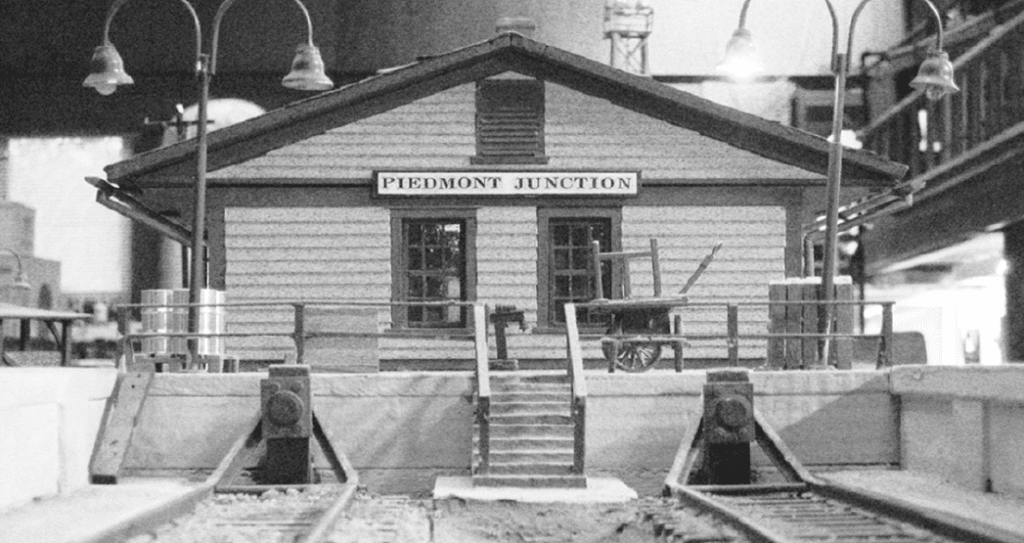RMCA History
The Railroad Model Club of Atlanta has met once a week continuously since its inception. In February of 2007 the club celebrated its 70th birthday and its 3,640th meeting without interruption.
It all began on February 22, 1937, a group of model railroad enthusiasts met at the home of Ingram Dickinson in suburban Atlanta to discuss the possibilities of organizing a model railroad club. From that meeting the club and its various layouts were born.
Initial space was obtained in the Sobeco Tannery in Norcross, Ga. Work had started on a layout here, but it soon proved that the space was inconvenient. The Southern Belting Company agreed to provide a space 21′ x 103′ in the fifth floor loft of their Atlanta factory in downtown Atlanta. In eight years from 1938 to 1946, the club built and nearly completed one of the largest two-rail O gauge layouts in the country, with over 1600 feet of track, and some 93 turnouts. This layout was in full operation and the scenery over half complete, when it appeared in the 1946 edition of Model Railroader.
In early 1946 the club was advised that the space it occupied would be needed for an expansion plan of the Belting Company, which of course required a complete dismantling of the layout. By mid 1946 a suitable building with a space 24′ x 73′ had been purchased by club member Clifford C. Cole, and the second floor was rented to the club on a long-term basis. Each member was given the opportunity to present his ideas for a track plan to fit the new space. From these discussions the present layout was developed, featuring easy grades and wide curves. As soon as the plan was approved, work had begun anew.
Equipment and some sections of the old dismantled layout were moved to the present location. In only three years, the new benchwork was near completion, track being installed, and the beginnings of scenery development were taking shape.
Operations
The Great Southern Lines is operated in true ‘Point-to-Point’ fashion utlizing large yard at both ends. We operate by reference to a printed timetable, utilizing more of a ‘time and position’ scheme rather than dealing with the pressure of strict ‘TT/TO’ systems. Passenger trains and hot freights ply the mainlines while local freights dodge them, working main line siding and servicing branch line customers.
Printed switch-lists cover car routing, with yard crews also switching some ‘in-limit’ industries.
The Layout

Equipment on the layout generally falls within the ‘Transition Era’ of late steam and early diesel, but some second-generaion diesels have also crept into the engine stall. Rolling stock generally conforms to NMRA standards for compatiblity.
Operation is point to point. The city of Ensley is located at the northern end, and Danville at the opposing southern end.
In Ensley, the larger of the terminals, extensive freight and passenger yards handle the flow of traffic. A large roundhouse, backshop and diesel repair facilities are located here, as well as a beautifully scratch-built downtown station.


The Wallace Division (between Ensley and Piedmont Jct.) is double track mainline, with a passing siding in the small town of Wallace. An intermediate division point occurs at Piedmont Junction, where two southbound single track main lines diverge, becoming the Clayton and Tyler Divisions (each named for the largest stations on their respective routes). These divisions join back together at Danville creating in effect a loop between PJ and Danville. This loop, as well as a hidden one at Ensley, provide for a continuous run during shows.
Multiple passing sidings, industry spurs and towns populate the routes between main cities. At Lakeland, on the Clayton Division, a branch line takes off up the mountain to serve Scott Mine #1. Steep grades and curves on this branch make it a must for geared locomotive (Shays, Heisler or Climax types) as were used on such lines in the early part of the last century.
Danville consists of two additional large yards, both freight and passenger, as well as a large terminal point roundhouse. This is a busy point on the railroad, handling traffice from the two divisions of the Clayton and Tyler.